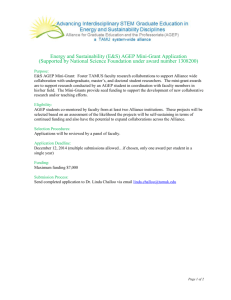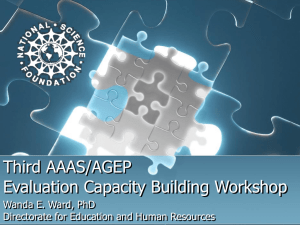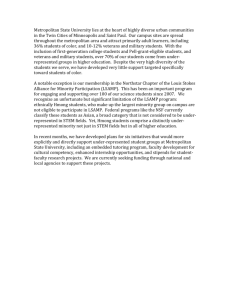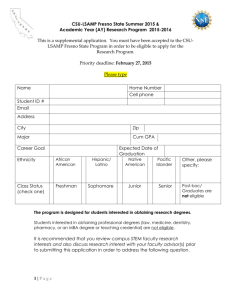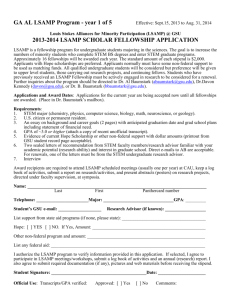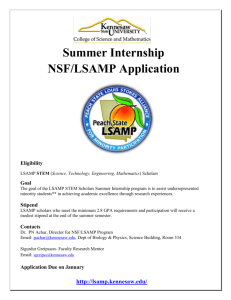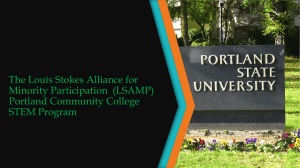wyche-forces-and
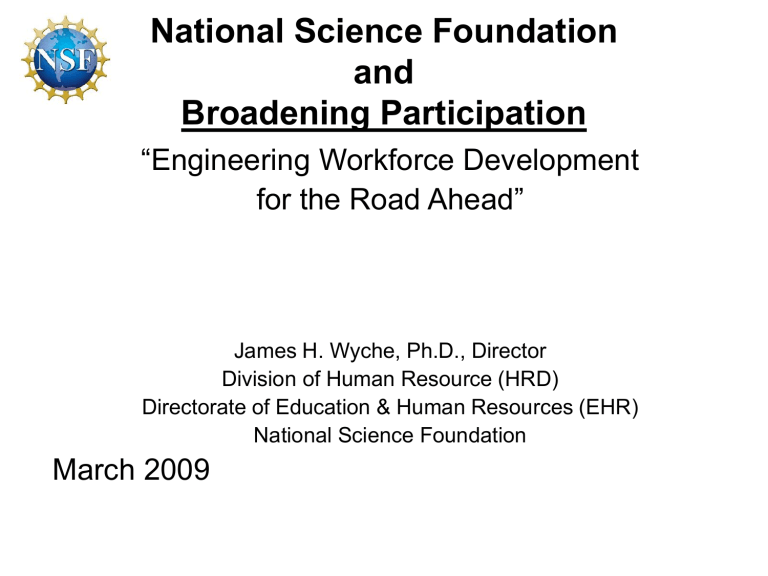
National Science Foundation and
Broadening Participation
“Engineering Workforce Development for the Road Ahead”
James H. Wyche, Ph.D., Director
Division of Human Resource (HRD)
Directorate of Education & Human Resources (EHR)
National Science Foundation
March 2009
Inspector General
A Look at NSF
National Science
Board
Director
Deputy Director
Staff Offices
Biological
Sciences
Computer,
Information
Science
& Engineering
Engineering
Social, Behavioral
& Economic
Sciences
Education
& Human
Resources
Geosciences
Budget, Finance
& Award
Management
Mathematical
& Physical
Sciences
Information
Resource
Management
Education and Human
Resources (EHR)
HRD Programs According to Theme and
Population
Populations
Themes
Education Research and
Demonstration
Enhancement of Institutional
Education Capacity
Minorities and
Minority-Serving
Institutions
HBCU-UP
LSAMP
HBCU-UP, LSAMP BD,
TCUP
Women and Girls
GSE
GSE
ADVANCE Enhancement of Institutional
Research Capacity
Large-Scale Implementation
Dissemination
CREST,
HBCU RISE
ABP
I-cubed
ADVANCE
GSE
People with
Disabilities
RDE
RDE
RDE
RDE
Changing Environments
Increasing Participants
(students, faculty)
Capacity Building
GSE
LSAMP
RDE
CREST
HBCU-UP
TCUP
Research Directorates EPSCoR DGE DUE
ADVANCE
AGEP
DRL
Evaluation and Assessment
Transition Points and HRD Program
Gaps
Area HRD Program Level
STEM Teacher
Prep
Undergraduate to
Ph.D.
Ph.D. to Postdoc
Postdoc to
Professor
Faculty
Advancement
TCUP/STEEP
LSAMP, AGEP,
HBCU-UP
None
None
Community
College/Tribal
Colleges
Undergrad/Doctorate
Postdoc
Beginning Faculty
ADVANCE Faculty
Key HRD Workforce Development
Programs
Louis Stokes Alliances for
Minority Participation
(LSAMP)
Historically Black Colleges and Universities
Undergraduate Program
(HBCU-UP)
Alliances for Graduate
Education and the
Professoriate (AGEP)
Louis Stokes Alliance for Minority Participation
Pacific
Islands of
Opportunity
CSU
System California
PROGRAM DIRECTOR/STAFF:
LSAMP
North Star
LSAMP Active
LSAMP Alumni
LSAMP New
Tribal Colleges
All Nations
Colorado
Wisconsin
Upstate
Detroit
New York
Urban Mass
New York City
North East
Illinois
Missouri
Michigan
Phil. Region
Stony Brook
Indiana
Ohio
Mid East
UMD System
Wash-Hampton
Kentucky-West Roads
Virginia
Virginia/NC
Tennessee North Carolina
Western Alliance
UT-El Paso
System
Oklahoma
New Mexico
Texas
Arkansas
Louisiana
Alabama
South Carolina
Mississippi
Georgia-UNCF
Peach State
Florida-Georgia
Houston Xavier UNCF
Dr. A. James Hicks (ahicks@nsf.gov)
(703) 292-4668 * (703) 292-9018 (fax)
Martha James (mjames@nsf.gov)
(703) 292-7772
Dr. Harry Bass ( hbass@nsf.gov
)
CONTACT:
Division of Human Resource Development
Louis Stokes Alliances for Minority Participation (LSAMP)
(703) 292-8632
Puerto Rico
(703) 292-8447
LSAMP Program Specialist
Margie Johnson (mcjohnso@nsf.gov)
MAP DESIGN:
Sanya N. Clark
(sspencer@nsf.gov)
MAP REVISIONS:
April Boyd-Melvin
(abmelvin@nsf.gov)
Historically Black Colleges and
Universities-Undergraduate
Program (HBCU-UP)
New Program Guidelines
Broadens participation in the Nation’s STEM workforce by enhancing the quality of undergraduate STEM education at HBCUs.
9
Impact of HBCU-UP
HBCU-UP has supported the development of
STEM education and research at 80 HBCUs
(78%) since 2001, including funding for programs at 82% of the Nation’s 4 year HBCUs and 46% of the Nation’s 2 year HBCUs.
More than 16,000 STEM students have graduated from HBCU-UP supported institutions since
1998.
U.S. Students Studying Abroad
Increasingly, experiences abroad are coming to be seen as a critical component of education for U.S. students in the globalizing economy.
During the 2005-06 academic year, 223,534 U.S. students studied abroad in foreign institutions of higher education, representing an increase of 32,213 students (16.8%) over the number who had gone abroad in the 2003-04 academic year.
U.S. students were most likely to study in European nations: the United
Kingdom (32,109), Italy (26,078), Spain (21,881) and France
(15,602). China ranked 7th as the destination for 8,830 students, almost twice as many as the 4,737 who studied in China in 2003-04.
Female students showed a greater propensity to study abroad, accounting for 65.5% of U.S. students studying abroad in 2005-06. In
2005-06, white students accounted for 83.0% of U.S. students studying abroad with African American students constituting 3.5%,
Hispanics 5.4%, Asian Americans 6.3% and American Indians 0.6%.
Source: Nicole M. Di Fabio, Carolyn Brandi, Lisa M. Frehill. November
2008. Forthcoming in the 23rd Edition of Professional Women and
Minorities: A Total Human Resources Data Compendium
Female students showed a greater propensity to study abroad, accounting for 65.5% of U.S. students studying abroad in
2005-06. In 2005-
06, white students accounted for 83.0% of U.S. students studying abroad with
African American students constituting
3.5%, Hispanics
5.4%, Asian
Americans 6.3% and
American Indians
0.6%.
AGEP and SBE Alliances for Graduate
Education and the Professoriate
Participating Institutions
Leveraging Broader Impacts
Underrepresented Minority PhDs Produced Across
All STEM Disciplines (2002 –2006)
54%
AGEP from 102 institutions
46%
Non-AGEP from 181 institutions
49% AGEP from 45 institutions
51 %
Non-AGEP from 45 institutions
53% AGEP from 91 institutions
47%
Non-AGEP from 156 institutions
45%
Non-AGEP
55% AGEP from 91 institutions from 153 institutions
Source: NSF Survey of Earned Doctorates/Doctorate Records File and AGEP.us
2
51% AGEP from 48 institutions
49%
Non-AGEP from 54 institutions
Underrepresented Minority PhDs Produced in
Engineering (2002 –2006)
58%
AGEP from 80 institutions
42%
Non-AGEP from 97 institutions
56% AGEP from 19 institutions
44%
Non-AGEP from 15 institutions
62% AGEP from 66 institutions
38%
Non-AGEP from 79 institutions
44%
Non-AGEP
56% AGEP from 71 institutions from 80 institutions
Source: NSF Survey of Earned Doctorates/Doctorate Records File and AGEP.us
7
60% AGEP from 18 institutions
40%
Non-AGEP from 11 institutions
U.S. population 18 –24 years old, by race/ethnicity:
July 1990 –99 and projections to 2050
Bachelor’s degrees awarded to racial/ethnic groups in S&E fields: 2004
Bachelor’s degrees awarded in S&E and non-S&E fields, by sex: 1966 –2004
Field distribution of S&E graduate students, by race/ethnicity: 2005
Female share of S&E graduate students, by field:
1995 and 2005
Female share of S&E postdoctoral fellows, by field: 1995 and 2005
Doctoral science and engineering faculty, by race/ethnicity and country of birth: 2003
International Research Activities
Africa
Caribbean/Latin America
South America
Successful Products of Future
Workforce Development
Arlie O. Petters
Professor of Mathematics, Physics, and Business Administration
Duke University: Arts & Sciences and Fuqua School of Business
Education:
Ph.D. MIT, 1991 (Mathematics)
Ph.D. thesis advisors: Bertram Kostant (MIT) and David
Spergel (Princeton University)
Ph.D. thesis title: Singularities in Gravitational
Microlensing
PRINCETON UNIVERSITY,1988-1991 (Exchange
Scholar; in absentia from MIT)
MIT, 1986-1988 (Department of Mathematics);
B.A./M.A. HUNTER COLLEGE - C.U.N.Y.,1986
(Mathematics and Physics)
M.A. thesis title: The Mathematical Theory of General
Relativity
Erich D. Jarvis, Ph. D.
Principal Investigator
Dr. Jarvis has a Ph.D. from Rockefeller University of New York in
Molecular Neurobiology & Animal Behavior.
EDUCATION
1979-1983 Scholarships to Geoffrey Ballet and Alvin Ailey Dance Schools, NY
1979-1983 Dance Major, High School of the Performing Arts, NY
1983-1988 B.A., Double: Biology &
Mathematics. Minor: Chemistry.
Hunter College, NY
1988-1995 Ph.D., Molecular Neurobiology
& Animal Behavior, The Rockefeller
University, NY
1995-1998 Postdoc. Molecular
Neurobiology & Animal Behavior, The
Rockefeller University, NY
Terrance D. Carroll represents clients in regulatory, civil and employment litigation matters. He also represents clients before various federal administrative and regulatory agencies. Aside from practicing law, Terrance is the
Colorado State Representative for House District 7. He is the Assistant Majority Leader for the Colorado House of
Representatives and serves as chairman of the House
Judiciary Committee.
STRATEGIC PLANNING &FUTURE DIRECTIONS
Full scale longitudinal evaluation of all HRD programs
Broadening participation & workforce issues are goals and endpoints for all HRD program objectives
Examine the role of community colleges in STEM student production for HRD programs
Create initiatives that close the gap on transition points in the development of STEM students through the professional pathway
Create and sustain collaborations within the NSF, with other federal agencies, and private organizations that enhance STEM workforce development
Create an globally competitive workforce
